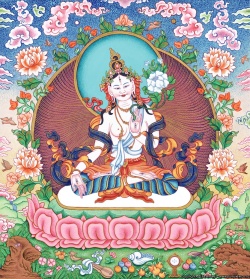Tarani Bosatsu
Tara Bosatsu 多羅菩薩 also called Tarani Bosatsu (Skt. = Tārā Bodhisattva; Chinese = Duōluó Púsà; Korean = Dara Bosal 다라보살)
Kannon's female manifestation. Also known as Tarani Bodhisattva. Goddess. One of 33 Forms of Kannon. Not until the 4th century AD does the feminine principle gain acceptance in Mahayana traditions in mainland Asia. Around the 6th century, the goddess Tara appears as Kannon's Śakti, the "female personification" or "female energy" of the male Kannon. Tara is sometimes depicted as Kannon's wife; not widely known in Japan or China. In China, said to have sprung from the eye of Guanyin (Kannon).
In the 7th century, the Chinese pilgrim Xuanzang claimed to have seen many statues of this deity in northern India. However, the deity was not accepted by followers of the Theravada, and her images are found rarely in Sri Lanka or in Southeast Asia (except in Java, where a temple was dedicated to her in 779).
Many legends have sprung up around this goddess. According to one, she was born in a beam of blue light emanating from one of the eyes of Avalokitesvara (i.e., Kannon). In Tibet, around the 7th century, came the idea that virtuous and pious woman were incarnations of Tara. Two of the wives of King Srong-btsan Sgam-po of Tibet -- the Chinese woman Wencheng and the daughter of Nepal's Amsuvarman -- are considered to be manifestations of Tara. To differentiate between the two wives, the Tibetans created two distinctive Taras, white for the Chinese, with a full-blown lotus as her emblem, and green for the Nepalese, whose emblem is the blue (half-open) lotus. Each was supposedly born from an eye of Avalokitesvara (open and half-closed). Hence they came to be considered as symbols of the day (full-blown lotus, eye open) and the night (half-open lotus, eye half-closed). In China, this goddess is not well known or represented. In Japan, she was given the rank of Bodhisattva, where her manifestation combines both colors, but she is found only rarely in Japan, and usually only on mandalas or on temple banners. She holds a pomegranate (symbol of prosperity) and a lotus, and is normally depicted in pale green color (in Japan, the word for blue can also be used for the color green)
Says JAANUS: "A female form of Kannon who appears as the 'mother' of the Kannon section (Kannon-in 観音院 or Renge-in 蓮華院) of the Taizoukai Mandara 胎蔵界曼荼羅. It is recorded that Xuanzhuang (Jp: Genjou 玄奘, d. 664) saw the image Tara Bosatsu in India, and several texts devoted solely to her were translated from the end of Tang and during the Song Dynasties (10th to 13th centuries). She is mentioned in the FUKUUKENJAKU SHINPEN SHINGONGYOU 不空羂索神変真言経. She appeared in art in India as an attendant of Kannon in the Gupta period (6-7c); was shown commonly as a single deity in sculpture of the Pala period (9-12c); is shown in relief sculptures in Java in the 8-9c; was and is, in Tibet, a female alternate of Kannon; and appeared in her Indian/Tibetan form in paintings at Dunhuang (Jp: Tonkou 敦煌). However, she appears not to have had an independent cult in Japan, since there are no independent images. In the Taizoukai Mandara she holds a lotus and is clothed from her neck to her ankles in robes that reveal nothing of her physique. An alteration from her Indian representation may have occurred in China."
